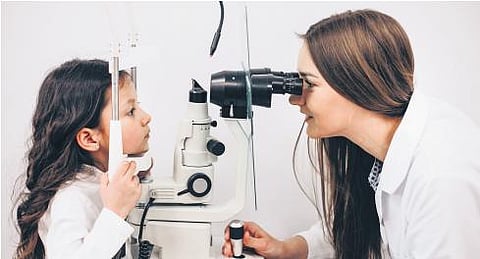Myopia: Curable if sighted early
Can you read a map clearly, but have trouble while driving a car? Chances are you have myopia, commonly known as nearsightedness. In myopia, a person can see objects that are near, but finds it difficult to see objects far away.
This common condition begins in childhood and adolescence and progresses as the eyes grow. “If left untreated before the age of eight, then the damage becomes permanent,” Isha Chaudhari, consultant, cataract cornea and refractive services, Dr. Shroff's Charity Eye Hospital, Delhi.
According to recent studies, the incidence of myopia in India is higher than in some western countries, said Dr Rohit Shetty from Narayana Nethralaya, Bengaluru.
The rise in myopia can be attributed to multiple factors, including genetic predisposition, increased screen time, reduced outdoor activities and urbanisation.
Myopia prevalence has been steadily increasing, with around 30% of the world's population estimated to be suffering from nearsightedness. Shetty said this vision disorder has far-reaching implications for public health, as it affects millions worldwide.
Experts said myopia has become a leading cause of visual impairment in children, especially after Covid-19 in India, as children spent more time on-screen due to online learning and limited outdoor activities.
“Since Covid-19, outdoor activities of children have gone down and screen activity has increased. It is crucial to detect it early and it is here that the role of both parents and teachers is important. They should keep an eye for signs such as difficulty in seeing distant objects. Checkups every six months can also help in early detection of myopia in children,” added Isha.
However, testing children under three-years-old with their vision may be challenging, said Dr Kalpit Shah, associate professor in ophthalmology at M&J Western Regional Institute (civil hospital), Ahmedabad.
Signs like straining to see distant objects, squinting or closely approaching items for improved visibility or preference for indoor activities over outdoor play may also signal a child's struggle with distant vision.
“Vision charts are available for children between 3-5 years old. If a child struggles to decipher the chart, it may hint at vision problems,” said Dr Shah.
Children should be categorised into three primary groups for myopia assessment: early infancy (under one year), preschool (under four years) and school-age (five years and above).
Treatment
Though glasses are the most common treatment, atropine eye drops at 0.01% concentration, administered in controlled doses over two to three years, have shown promise in slowing its advancement.
As myopia tends to worsen with elongation of the eye, low-dose atropine is recommended for children aged 5-18. “These drops should be used at night to slow the progression of myopia. But their usage should be overseen by a pediatric ophthalmologist,” added Dr Shah.
Children between the ages of 6 and 12 with myopia may consider peripheral defocus contact lenses. Orthokeratology or Ortho-K, multifocal contact lenses are also an option.
However, LASIK, also known as laser-assisted in situ keratomileusis, surgery is not recommended until the age of 17 to 18. Exceptions are made in cases where a child exhibits severe refractive error in one eye. For adults, there are several corrective surgeries and it is primarily advised for those with a negative power of 7 to 8.
“SMILE and SILK (smooth incision lenticule keratomileusis) are the latest procedures used for spectacle correction. In cases of moderate to high myopia, individuals also have the option of considering implantable Collamer Lenses (ICLs) as an alternative surgical intervention,” said Dr Ajay Sharma, chief medical director at EyeQ, Gurugram, Haryana.
“These procedures provide a means to enhance vision, potentially freeing individuals from dependence on glasses or contact lenses,” he added.
“SILK has brought a groundbreaking approach to laser vision correction specifically designed to treat myopia, whether with or without astigmatism - a common eye problem that can make your vision blurry or distorted,” said Shetty.
“What sets SILK apart is its flapless technique, which can lower the risk of complications. SILK also boasts faster recovery, minimal dryness and exceptional visual results.”
Cutting-edge technologies like intraocular lenses and artificial retinas are restoring vision for those with previously untreatable conditions, he added.
“These innovations have improved the quality of life for countless individuals, reducing dependence on glasses and providing newfound hope for those with severe visual impairments, exemplifying remarkable strides made in eye surgery,” Shetty said.
Catch it young
Dr Nirati Srivastava, Consultant Ophthalmology, Regency Hospital Ltd, Kanpur, said that the best way is for parents to encourage their children to spend more time outdoors and limit screen time on digital devices.
Balancing outdoor activities with screen time may assist in managing myopia and safeguarding long-term vision, she added.
Managing nearsightedness entails regular monitoring for potential complications such as glaucoma, cataracts and retinal detachment, said Dr Maansi Sethi, Consultant Ophthalmology, Ujala Cygnus Central Hospital, Haldwani, Uttarakhand.
Additionally, myopia can lead to functional impairments, affecting daily activities like reading and driving. Regular eye examinations are crucial for early detection and management of myopia, she added.
This will also help reduce risk of complications like poor school experiences, reduced quality of life, impaired safety and other eye problems.

